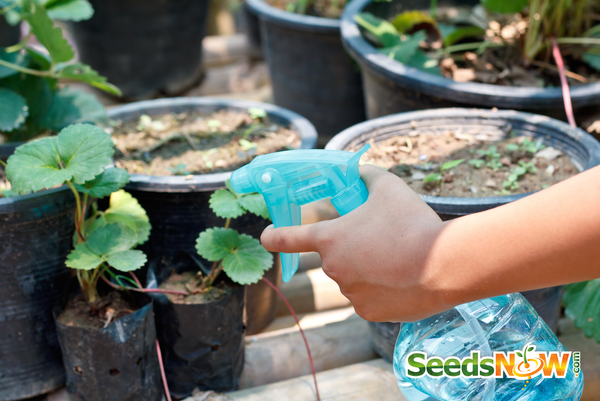Getting Started: Dealing with Pests in the Garden
← GO BACK TO GROW GUIDES
 As in so many areas of life, the best pest control in organic gardening is prevention. As much as possible within the space of your garden, rotate (move) your crops around the garden so that no crop is planted in the same place for at least three years.
As in so many areas of life, the best pest control in organic gardening is prevention. As much as possible within the space of your garden, rotate (move) your crops around the garden so that no crop is planted in the same place for at least three years.
Not only should you keep the same plant from going in the same place, but keep other related plants out, too. This will help save your plants from both diseases and pests that build up in the soil around the roots of a particular kind of plant.
In addition, it’s good to grow as many different crops as you feel comfortable taking care of. Besides giving you some harvest even if one of your crops is completely destroyed by pests, this diversity is itself a form of pest control – pests move quickly through large plantings of the same crop, but more slowly through small plantings of diverse crops.
Most plants have few defenses when they are small, but as they grow older, their stems get thicker and less tasty for insects, and they develop the ability to release bitter or otherwise unpleasant substances in response to insect feeding. Their resistance to disease also increases.
If you have used the various preventative tactics mentioned above and you still have insect pest problems, there are some compounds that are used as organic pesticides. Keep in mind that these compounds are not like some of the conventional insecticides you might have used in the past – if they are o.k. for use in organic production, they are less toxic to your health, or at least break down more quickly in the environment than standard pesticides. Most of these compounds only kill insects when the insects are very small (larvae, or worm-like creatures, rather than adults). Also, most of these compounds are only effective for a day or two after you apply them, after which point they are destroyed by sunlight, rain, or just exposure to the air.
Use a molasses spray to keep bugs off your plants.
Organic molasses mixed with a few simple ingredients sprayed on plants, will help drive off harmful insects while giving your plants a boost. Insects like a very specific window of sugar content in plants. If you raise that, they will not want to eat it and if they do will die. Insects cannot bloat or release gas, therefore sugars create gas and it basically kills them from the inside out.
 Though bugs hate it, plants love it.
Though bugs hate it, plants love it.
Adding molasses to the soil in your garden helps to increase the microbial activity resulting in soil that holds moisture better and is also easier to plant in. When soil microbes are exposed to simple sugars, they multiply quickly. As microbes go through their living cycle, they add important nutrients to the soil, therefore, the more the merrier. You can also rid your yard of fire ants by spraying this over your grass too. This is the most inexpensive way to add sugars and ward off harmful insects to your garden and vegetable plants.
Simple Molasses recipe for soil and plants: (spray bi-weekly directly onto the leaves)
Which Organic home remedies do you use to combat pests in your garden?
← GO BACK TO GROW GUIDES

Not only should you keep the same plant from going in the same place, but keep other related plants out, too. This will help save your plants from both diseases and pests that build up in the soil around the roots of a particular kind of plant.
In addition, it’s good to grow as many different crops as you feel comfortable taking care of. Besides giving you some harvest even if one of your crops is completely destroyed by pests, this diversity is itself a form of pest control – pests move quickly through large plantings of the same crop, but more slowly through small plantings of diverse crops.
Most plants have few defenses when they are small, but as they grow older, their stems get thicker and less tasty for insects, and they develop the ability to release bitter or otherwise unpleasant substances in response to insect feeding. Their resistance to disease also increases.
If you have used the various preventative tactics mentioned above and you still have insect pest problems, there are some compounds that are used as organic pesticides. Keep in mind that these compounds are not like some of the conventional insecticides you might have used in the past – if they are o.k. for use in organic production, they are less toxic to your health, or at least break down more quickly in the environment than standard pesticides. Most of these compounds only kill insects when the insects are very small (larvae, or worm-like creatures, rather than adults). Also, most of these compounds are only effective for a day or two after you apply them, after which point they are destroyed by sunlight, rain, or just exposure to the air.
Use a molasses spray to keep bugs off your plants.
Organic molasses mixed with a few simple ingredients sprayed on plants, will help drive off harmful insects while giving your plants a boost. Insects like a very specific window of sugar content in plants. If you raise that, they will not want to eat it and if they do will die. Insects cannot bloat or release gas, therefore sugars create gas and it basically kills them from the inside out.
 Though bugs hate it, plants love it.
Though bugs hate it, plants love it.Adding molasses to the soil in your garden helps to increase the microbial activity resulting in soil that holds moisture better and is also easier to plant in. When soil microbes are exposed to simple sugars, they multiply quickly. As microbes go through their living cycle, they add important nutrients to the soil, therefore, the more the merrier. You can also rid your yard of fire ants by spraying this over your grass too. This is the most inexpensive way to add sugars and ward off harmful insects to your garden and vegetable plants.
Simple Molasses recipe for soil and plants: (spray bi-weekly directly onto the leaves)
- 3 T. organic molasses
- 1T. liquid organic garlic
- 1T. liquid organic fertilizer
- 1 gallon of water
Which Organic home remedies do you use to combat pests in your garden?
← GO BACK TO GROW GUIDES
ON SALE NOW UNTIL MIDNIGHT
FEATURED BLOG POSTS & ARTICLES
VIEW ALL BLOG POSTS
38 Edible Flowers To Plant In Your Garden
Nothing will impress your friends and family like sprinkling some colorful flowers into a salad, onto pastries or even as a garnish in their favorite drinks. Edible flowers will add a beautiful splash of color to many dishes and they are readily available, when you're growing them right in your own garden.

15 Herbs You Can Grow at Home To Make Your Own Tea
These 15 herbs will make a wonderful addition to your collection of "tea making supplies"! Start curing your ailments naturally by growing your own herbal remedies. You can use them individually or mix and match to create unique tones and flavors that are suitable to your own liking.

Your Guide to Gardening Through all 4 Seasons
As the weather becomes consistently cold (in late October and early November, in the upper Midwest), you can work at preparing your garden for winter. There are several aspects to winter preparation.

How to Deal with Squash Bugs
Squash bugs can destroy crops and are quite the nuisance. Check your squash plants daily for signs of squash bugs and their eggs.
What to look...

How to Save 🍅 Tomato Seeds
There are several ways that you can save your heirloom tomato seeds, but here are two of the most popular techniques.
Fermentation Method:
Choos...

How To Tell When 🍆 Eggplant Is Ripe
Eggplant is a versatile fruit often used in Italian dishes such as ratatouille, caponata, and lasagna. Eggplant easily absorbs the flavors of wh...

Start these NOW for a fall garden!
Summer will soon be over but having a thriving vegetable garden doesn't have to end when summer does. With a little bit of planning, and p...

How Many Plants a 12″ Container?
Here is a suggested number of plants that will grow successfully in a 12″ container. It would be a waste of money and time to start more seeds...


